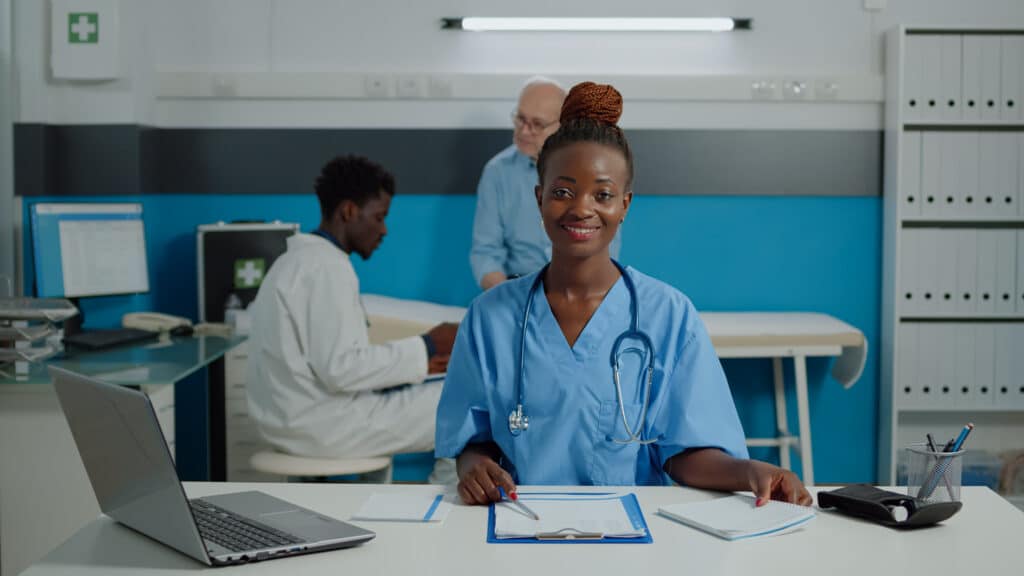If you have ever visited a doctor’s office, you have likely encountered a medical assistant (MA). If you want to start your career as a medical assistant, then you should develop a clear understanding of the duties of a medical assistant.
Medical Assistants are known for their versatility, as they handle both clinical and administrative tasks, ensuring that medical facilities operate smoothly and patients receive quality care.
So, in this article, first, we’ll discuss the job duties of a clinical medical assistant and an administrative medical assistant.
Then, we’ll take a deep dive into a day in the life of a Medical Assistant.
Lastly, we’ll discuss the #1 thing that employers seek in the resume of a fresh medical assistant, and how you can get that thing faster.
So, stay tuned.
What is a Medical Assistant?
Medical assistants are healthcare professionals who support physicians in various outpatient settings, such as clinics, labs, and government agencies. They work closely with doctors to streamline their workflow, making patient care more effective and efficient. This role is essential for the overall operation of medical facilities, as medical assistants can handle both clinical and administrative tasks.
There are two primary types of medical assistants: clinical medical assistants and administrative medical assistants. However, because they receive training in both areas, these roles often overlap depending on the size and needs of the facility.
Types of Medical Assistants
1. Clinical Medical Assistants
Clinical medical assistants are often the first point of contact for patients when they visit a doctor’s office. They perform various duties to help doctors provide quality care. Their tasks include:
- Greet patients and prepare them for examination.
- Taking vital signs (e.g., blood pressure, temperature).
- Gathering patient medical history.
- Assisting with simple medical procedures, injections, and tests such as EKGs and spirometry.
- Drawing blood and running lab tests.
- Setting up examination rooms according to the physician’s requirements.
- Providing wound care and aftercare instructions.
In addition to direct patient care, clinical medical assistants often perform several administrative tasks. These tasks can involve:
- Coordinating patient referrals to specialists.
- Following up on notes from referring doctors.
- Handling prior authorizations and insurance verifications for tests, procedures, and medications.
Clinical medical assistants are crucial for ensuring that doctors have all the information and tools they need to deliver effective patient care.
2. Administrative Medical Assistants
Administrative medical assistants usually manage the front desk and handle tasks related to the patient’s medical records. Their responsibilities include:
- Checking patients in and out of the facility.
- Posting payments and conducting insurance verification.
- Scheduling and following up on appointments.
- Ensuring that all patient registration, consent forms, and insurance verification documents are complete.
- Maintaining up-to-date and organized patient charts.
- Communicating with patients over the phone, relaying messages to the appropriate clinical medical assistant.
While these tasks might seem different from those of clinical medical assistants, the roles often overlap. Medical assistants must be flexible and capable of performing both clinical and administrative duties, especially in smaller facilities where staff may need to take on multiple responsibilities.

Daily Duties of a Medical Assistant
A Day in the Life of a Clinical Medical Assistant
A typical day for a clinical medical assistant involves directly interacting with patients and assisting physicians. They:
- Greet Patients: Upon arrival, clinical medical assistants greet patients and escort them to examination rooms. They may need to assist patients in getting undressed or prepared for specific procedures.
- Prepare Examination Rooms: Before the physician arrives, they set up the room according to the procedure to ensure that the doctor has everything needed.
- Perform Diagnostic Tests: Perform basic diagnostic tests, such as drawing blood for lab tests or conducting electrocardiograms (EKGs).
- Administer Tests and Treatments: They may administer injections, measure medications, or perform procedural testing such as auditory or visual acuity tests. In some cases, they assist with surgeries or wound care.
- Manage Administrative Clinical Tasks: During “downtime,” when patients are not in the office, clinical medical assistants handle administrative clinical duties. These include:
- Completing patient forms and paperwork.
- Returning patient calls and refilling prescriptions.
- Following up on referrals, lab results, and prior authorizations for tests.
A Day in the Life of an Administrative Medical Assistant
Administrative medical assistants are primarily involved in the front desk operations. Their day-to-day duties include:
- Check-In and Check-Out: They handle patient check-ins, verify insurance information, and ensure patients are ready for their appointments. During check-out, they schedule follow-up appointments and process payments.
- Communication and Scheduling: They are often the first point of contact for phone calls, directing patients to the appropriate clinical staff. They also manage appointment schedules and handle cancellations or rescheduling as needed.
- Insurance Verification: Conducting insurance verification either before or on the day of the appointment is a crucial part of their role to ensure coverage for the necessary procedures.
- Maintain Medical Records: They ensure patient charts are updated with registration forms, consent forms, and any necessary authorizations for information release. They also handle requests for medical records.
The #1 Thing Employers Want
When it comes to hiring Medical Assistants, the most sought-after qualification is a Certification. Employers highly value this credential because it serves as concrete evidence that the individual has the necessary skills and knowledge to perform effectively in a healthcare setting.
Certification is not just a formality; it’s a critical factor that can significantly impact your career prospects.
According to a survey by the National Healthcareer Association (NHA), about 89% of employers either prefer or require Medical Assistants to be certified.
This strong preference underscores the importance of certification in the hiring process. Reputable organizations like the American Association of Medical Assistants (AAMA) and the NHA conduct rigorous exams that you must pass to earn your certification.
Holding a certification demonstrates your readiness and competence in essential Medical Assistant skills, which is why it’s so highly regarded by employers.
The U.S. Bureau of Labor Statistics (BLS) reports that Certified Medical Assistants earn a median salary of $42,000, with the top 25% making up to $47,000 annually.
If you’re aiming to become a Medical Assistant and are looking for an affordable training program, we offer a program that could be the perfect fit for you.
But before diving into that, let’s explore the steps to becoming a Certified Medical Assistant.
Key Skills for Medical Assistants
To be successful in this role, medical assistants need to possess several important skills:
- People Skills: A genuine liking for people is crucial for medical assistants. Whether working directly with patients or communicating over the phone, being friendly and approachable helps in building a rapport with patients, making them feel comfortable and cared for.
- Communication Skills: Clear communication is vital, as medical assistants are often the first point of contact for patients. They must be non-judgmental, both verbally and non-verbally, to ensure patients feel safe sharing important medical information.
- Attention to Detail: Medical assistants handle sensitive information and legal documents. Attention to detail is essential to document everything accurately, ensuring that patient records are complete and reflect the care provided.
- Accountability: Mistakes can happen, even in healthcare. Medical assistants must be honest and take responsibility for any errors. Demonstrating trustworthiness and reliability helps maintain a high standard of care and builds trust with patients and employers.

How to Become a Medical Assistant
One of the benefits of becoming a medical assistant is the relatively short training period. Unlike nursing or medical school, which require years of education, medical assistants only need a high school diploma or GED to start towards their journey.
Steps to Becoming a Medical Assistant
- Complete Your Education: Obtain a high school diploma or GED. This is the minimum educational requirement for enrolling in a medical assistant program.
- Choose an Accredited Program: Look for a medical assistant program at an accredited college or university. Many programs offer flexibility, allowing you to study online from the comfort of your home.
- Get Certified: After completing your medical assistant training, take the certification exam. Passing this exam will qualify you to work as a certified medical assistant, allowing you to join a healthcare team and jump-start towards your career in the medical field.
Preppy’s Medical Assistant Training Program

Overview
Preppy’s Medical Assistant Training Program is entirely online and self-paced, making it ideal for students who need flexibility. Preppy’s program is offered in partnership with Auburn University, providing a reputable university certificate upon completion.
Program Highlights
- Mode of Delivery: 100% online and self-paced.
- Program Duration: Could be completed in as little as 4 to 6 months, with access for up to a year.
- Tuition Cost: Just $1,599.
- Certification: Prepares students for the CCMA certification exam.
- Practical Experience: Includes an externship opportunity at a local healthcare facility.
- Additional Benefits: Offers job assistance services for eligible graduates and a free laptop if you pay the tuition in full.
Conclusion
Medical assistants play a vital role in the healthcare system, helping doctors deliver effective patient care while managing various administrative tasks. Whether you’re assisting patients directly or handling administrative duties, being a medical assistant offers a fulfilling career in the medical field. With just a high school diploma and a few months of training, you could become a key member of a healthcare team, making a difference in patients’ lives every day.
Also read: Is Being a Medical Assistant Worth It?
About:
Preppy was founded by higher education expert, Grant Aldrich, whose work on college affordability and accessibility has been featured in Forbes, Bloomberg Businessweek, Business Insider, American Express, AOL, MSN, Thrive Global, Reader’s Digest, Inside Higher Ed, Evolllution, EducationDive, and nearly 100 radio shows and podcasts.
Time is money. Instead of programs that could take 2 years, Preppy provides you with education in a few months through immersive online training.
Healthcare, IT, Business, Trades…Preppy gets you ready for the trending careers in our modern economy.
Our team of higher education and startup veterans has created the best solution so everyone can obtain the emerging careers of today and tomorrow.
We look forward to speaking with you. You may also call 800-729-1317.
Medical assistantWhat does a Medical Assistant Do?





